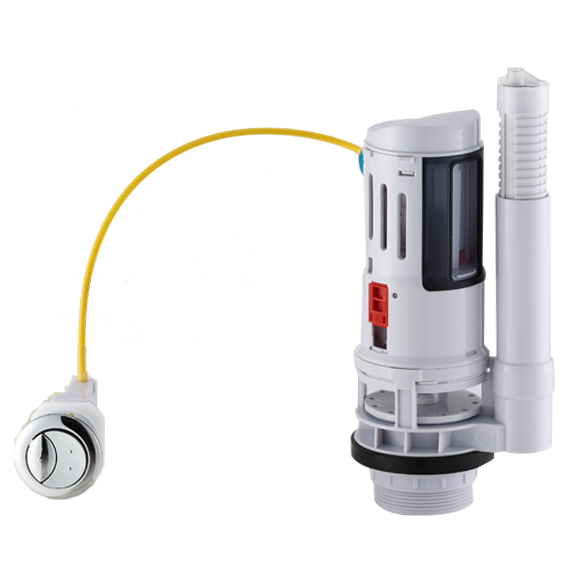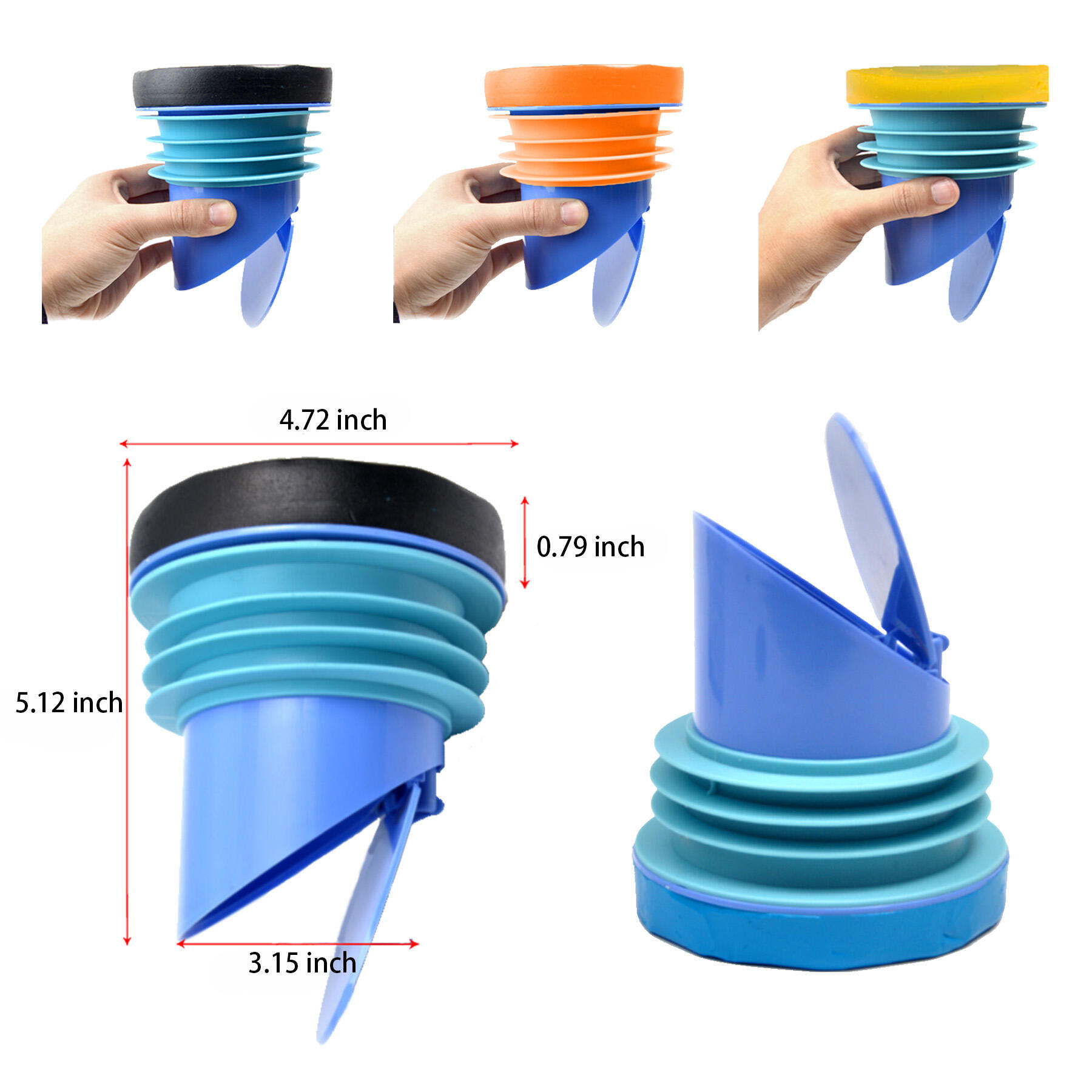كيف صمامات الفحص للمرحاض كيف تعمل ولماذا هي مهمة
ما هو صمام فحص المرحاض وكيف يمنع التدفق العكسي؟
صمامات التفريغ في المراحيض هي أجهزة ميكانيكية مصممة أساسًا للحفاظ على تدفق المياه في اتجاه واحد فقط ومنعها من العودة للخلف. أكثر الأنواع شيوعًا التي نراها هي صمامات الفتحة المتأرجحة، والتي تحتوي على قرص صغير داخلي مفصل. عندما تدفع المياه بشكل طبيعي، يفتح القرص ويتحرك جانبًا، ولكن إذا حدث أي تدفق عكسي، فإن القرص يُغلق بإحكام. لماذا يهم هذا؟ حسنًا، بدون هذه الصمامات، قد تتدفق مياه الصرف الملوثة بالفعل إلى أنابيب المياه النظيفة، مما سيكون خبرًا سيئًا جدًا لأي شخص يعتمد على إمدادات المياه هذه. تنخفض مخاطر التلوث بشكل كبير عندما يتم تركيب هذه الأجهزة البسيطة بشكل صحيح في أنظمة السباكة.
الوظيفة الأساسية في أنظمة السباكة المنزلية
تُعد هذه الصمامات وسيلة وقائية حيوية في سباكة المنازل، حيث تحافظ على ضغط المياه باستمرار وتمنع ارتجاع مياه الصرف. عند شطف المراحيض أو حدوث ازدحام في أنظمة التصريف، تقوم صمامات الفحص بعزل الأجزاء المتضررة، مما يقلل من مخاطر التلوث المتبادل بين خطوط مياه الصرف والمياه العذبة.
دور التحكم الآلي في تدفق المياه في المراحيض
تعمل صمامات الفحص بشكل سلبي باستخدام ديناميكا السوائل بدلاً من مصادر الطاقة الخارجية. أثناء دورات التفريغ، يرفع ضغط الماء آلية الصمام للسماح بإزالة الفضلات. وبمجرد انخفاض الضغط، تُجبر الجاذبية والتدفق العكسي على الإغلاق الفوري، وهي ميزة أمان تعمل حتى أثناء انقطاع التيار الكهربائي أو أعطال المضخات.
حالات الاستخدام الرئيسية في المراحيض وأجهزة الحمامات
تحافظ صمامات الفحص في المراحيض على تدفق المياه الملوثة من العودة إلى شبكة إمداد المياه النظيفة، ولهذا السبب يقوم السباكون عادةً بتركيبها في أماكن مثل صمامات ملء المرحاض، وأجهزة رش البيديت التي يُثبتها الناس حاليًا، وأحيانًا حتى في مصارف الدش. في الواقع، تحافظ هذه الأجهزة الصغيرة على انتقال المجاري إلى خزانات المرحاض عندما يحدث انخفاض في ضغط مياه المدينة. ويكتسب ذلك أهمية لأن كود البناء يتطلب هذا النوع من الحماية لمنع اختلاط المياه الملوثة بالمصادر النظيفة داخل المنازل. تحتاج معظم أنظمة السباكة السكنية إلى الامتثال لمعايير IPC لأسباب تتعلق بالسلامة، وبالتالي فإن توفر صمامات فحص مناسبة ليس فقط ممارسة جيدة بل أصبح أمرًا إلزاميًا في الوقت الحاضر.
التكامل مع خطوط الصرف والأنظمة الصحية
صمامات الفحص للمرحاض تلعب دورًا رئيسيًا في أنظمة الصرف الحديثة من خلال فصل خطوط التصريف عن غازات المجاري ومنع تدفق مياه الصرف الصحي للخلف. تعمل هذه الصمامات بشكل أفضل عند تركيبها عموديًا داخل أعمدة التربة أو على طول خطوط التفريع الأفقية. فهي تسمح بمرور الفضلات إلى الأسفل، ولكنها تُكوّن ختمًا يمنع عودتها مرة أخرى إلى الأعلى. وفي حالة عدم وجودها، قد تتعرض حمامات الطوابق العليا لانسداد متكرر كلما حدث انسداد في مستوى أدنى. إنها مشكلة شائعة نسبيًا – وفقًا لبيانات معايير السباكة الوطنية للعام الماضي، تحدث واحدة من بين كل أربع حالات طوارئ صحية في المباني المتعددة الطوابق بسبب هذه المشكلة بالذات.
استخدامات موسعة في المباني السكنية والمباني المؤلفة من وحدات متعددة
تلعب صمامات الفحص دورًا حيويًا في المباني السكنية والشقق، حيث تمنع دخول المياه الملوثة إلى أنابيب الوحدات المجاورة وتساعد على منع حدوث الفيضانات في نظام الصرف المشترك. تشير أمثلة من الواقع إلى أن العقارات المجهزة بهذه الصمامات تسجل ما يقارب 41 بالمئة من المطالبات التأمينية الأقل المتعلقة بأضرار المياه مقارنةً بالعقارات التي لا تحتوي عليها، وفقًا للتقارير الصناعية. تشترط العديد من اللوائح الحضرية الآن تركيب هذه الصمامات في المباني المرتفعة تحديدًا، نظرًا لقدرتها على احتواء التسريبات الصغيرة قبل أن تتحول إلى مشكلات كبيرة، وحماية مديري المباني من الدعاوى القضائية المحتملة الناتجة عن أعطال السباكة في الأنظمة المتصلة عبر المبنى كله.
أنواع الصمامات الصمامات المتوافقة مع أنظمة المراحيض
الصمامات المتأرجحة، الرافعة، الكروية، والمتسلسلة: نظرة عامة على أنواع الصمامات
توجد أربع أنواع رئيسية من صمامات الفحص التي تعمل بكفاءة داخل أنظمة المراحيض. تحتوي صمامات الفحص المتأرجحة على آلية قرص مفصلية تُفتح بالتأرجح عندما يتدفق الماء إلى الأمام، ثم تغلق بالسقوط بفعل الجاذبية عند حدوث أي حركة عكسية. وعادةً ما تكون خيارًا جيدًا للصرف الرأسي. تشير أحدث معايير السباكة لعام 2023 إلى أن هذه الصمامات يمكنها تحمل ضغوطًا متوسطة ولكنها تحتاج إلى مساحة كافية حولها عند التركيب. بالنسبة للأنابيب الأفقية، تُستخدم غالبًا صمامات الفحص الرافعة نظرًا لأن تصميمها يشبه شيئًا ما مثل مكبس يتحرك لأعلى ولأسفل. ثم لدينا صمامات الفحص الكروية التي تقوم ببساطة بتدوير كرة صغيرة عبر الفتحة لمنع عودة الماء. أما الصمامات المتسلسلة (Inline) فتتبع نهجًا مختلفًا تمامًا باستخدام النوابض للمساعدة في إبقاء تلك الأقراص الصغيرة مغلقة بإحكام حتى في المساحات الضيقة حيث قد لا تناسب الخيارات الأخرى بشكل صحيح.
أفضل نوع صمام للتركيبات المنخفضة الضغط في المراحيض
بالنسبة للحمامات السكنية ذات الضغط المنخفض، فإن الصمامات الكروية هي الخيار الأمثل. إن آلية الكرة الخاصة بها تقلل من مقاومة التدفق (فقدان ضغط بمقدار 1.2 رطل/بوصة مربعة) وتمنع بشكل موثوق التدفق العكسي عند ضغوط التغذية بين 5 و15 رطل/بوصة مربعة. كما أن الأنواع المزودة بختم مطاطي تقاوم تراكم الرواسب، حيث أظهرت الاختبارات الميدانية حدوث مشكلات صيانة أقل بنسبة 92٪ مقارنة بالصمامات المتأرجحة في ظروف مماثلة.
مقارنة كفاءة التدفق، والمتانة، واحتياجات الصيانة
| نوع الصمام | كفاءة التدفق | العمر الافتراضي (سنوات) | تردد الصيانة السنوي |
|---|---|---|---|
| صمام فحص المتأرجح | معتدلة | 8–10 | 0.5–1 تفتيش |
| الصمام الكروي | مرتفع | 12–15 | 0.2–0.5 تنظيف |
| الصمام الخطي | مرتفع | 6–8 | 1–2 استبدال الحوافيز |
تقدم الصمامات المتأرجحة متانة جيدة ولكنها تؤدي أداءً ضعيفًا في ظل تدفق مضطرب. بينما توفر الصمامات الكروية كفاءة وعمرًا افتراضيًا أفضل، أما النماذج الخطية فهي مناسبة للتركيبات الضيقة على الرغم من ارتفاع احتياجاتها من الصيانة.
الوقاية من أضرار المياه وتقليل مخاطر المسؤولية
كيف تمنع صمامات التفتيش في المراحيض التدفق العكسي والأضرار الناتجة عن الفيضانات
تعمل صمامات التفتيش في المراحيض بشكل أساسي كأبواب أحادية الاتجاه، حيث تمنع مياه الصرف من التدفق عكسيًا عند حدوث مشكلات في نظام الصرف الصحي أو تغيرات في مستويات الضغط. وتحدث هذه المشكلات أكثر مما يتصور الناس، خاصة في المباني السكنية حيث تشترك الوحدات المتعددة في نفس البنية التحتية للسباكة. وتُغلق هذه الصمامات تلقائيًا كلما انخفض الضغط في الجزء العلوي، مما يمنع دخول المياه الملوثة إلى الحمامات. ويساعد ذلك ليس فقط على تجنب الفيضانات المزعجة، بل ويقي أيضًا من المشكلات طويلة الأمد مثل نمو العفن في كل مكان وبدء تآكل الجدران. ينبغي على مديري العقارات أن يأخذوا هذا الأمر بعين الاعتبار، لأن إصلاح الأضرار الناتجة عن المياه يكلف حوالي اثني عشر ألف دولار في كل مرة. ويمكن لتثبيت هذه الأجهزة البسيطة مقدمًا أن يوفر المال على المدى الطويل، مع الحفاظ على رضا المستأجرين وصحتهم.
دراسة حالة: تجنب الإصلاحات المكلفة في المجمعات السكنية
أظهر تحليل 120 منزلاً في عام 2023 أمرًا مثيرًا للاهتمام حول صمامات الفحص. فقد سجّلت المباني المجهزة بهذه الصمامات انخفاضاً بنسبة نحو 78 بالمئة في حالات عودة المياه إلى نظام السباكة. على سبيل المثال، قام أحد المجمعات السكنية المؤلفة من خمسين وحدة بتحقيق وفورات تقارب 92 ألف دولار على إصلاحات الصيانة خلال فترة ثلاث سنوات، بعد تركيب صمامات مناسبة عند كل اتصال بمراحيض الوحدات وفقاً لمواصفات البناء. ويُشير المسؤولون البلديون الذين يقومون بفحص العقارات بانتظام إلى أن حوالي أربعة من كل خمسة حالات انسداد في المجاري تبدأ بالفعل في حمامات الطابق الأول، وهو ما يُعد منطقياً نظراً لأن هذه هي بالضبط النقطة التي تكون فيها هذه الصمامات الخاصة أكثر فعالية في منع حدوث مثل هذه المشاكل منذ البداية.
خفض تكاليف الإصلاحات الطارئة والمخاطر القانونية
تُعد صمامات الفحص ضرورية عند الالتزام بمعايير IPC لمنع التدفق العكسي في المباني التي يعيش فيها عدد كبير من الأشخاص. أظهرت دراسة حديثة أن أصحاب العقارات الذين قاموا بتثبيت هذه الصمامات المعتمدة شهدوا انخفاضًا ملحوظًا نسبيًا في مطالبات تأمين الأضرار الناتجة عن المياه – حوالي 41 بالمئة وفقًا لمراجعة تأمين العقارات الصادرة العام الماضي. ومن المثير للاهتمام أن المباني التي حافظت على سجلات دقيقة لأعمال الصيانة تمكنت من تسوية مطالبات التأمين الخاصة بها بشكل أسرع بكثير، وبمعدل أسرع بنسبة 63٪ تقريبًا، كما هو مذكور في الإرشادات الصادرة عن شركات الاستعادة الرائدة. وعند النظر إلى كل هذه العوامل معًا، يتضح جليًا وجود حجة قوية تدعو الموزعين إلى الاحتفاظ بقطع غيار عالية الجودة ومعتمدة في المخزون. ففي النهاية، لا أحد يريد التعامل مع الفوضى والتكاليف المرتبطة بأضرار المياه التي يمكن منعها.

توفير التكاليف والعائد على الاستثمار للموزعين الذين يحتفظون بصمامات فحص المرحاض في المخزون
الحماية طويلة الأمد للعقارات تعني قيمة مضافة للعميل
عندما يقوم الموزعون بتخزين صمامات التحقق من المراحيض، فإنهم في الحقيقة يساعدون عملاءهم على تجنب مشكلات الأضرار الناتجة عن المياه والتي قد تكون جسيمة. فقط تخيل أن خللاً واحداً في نظام السباكة داخل مجمع سكني يمكن أن يتسبب في فواتير إصلاح تتجاوز الخمسة عشر ألف دولار وفقًا لمؤسسة السلامة الصحية للسباكة من العام الماضي. هذا النوع من المبالغ يتراكم بسرعة، ولهذا السبب تُعد هذه الصمامات جزءًا مهمًا في الحفاظ على قيمة العقارات. الموزعون الذين يحملون هذه المنتجات لا يبيعون فقط، بل يصبحون شركاء موثوقين عندما يتعلق الأمر بالوقاية من المفاجآت المكلفة في المستقبل.
زيادة الهوامش من خلال المكونات الوقائية ذات الطلب المرتفع
تُصنف صمامات التحقق من المراحيض ضمن أعلى خمسة مكونات صحية هيدروليكية ربحية بسبب الطلب المتزايد الناتج عن لوائح البناء. ويُبلغ الموزعون عن هوامش ربح إجمالية تتراوح بين 22٪ و35٪، وهي نسبة أعلى بكثير من النطاق 8٪ إلى 12٪ المعتاد للمواسير القياسية. كما أن حجمها الصغير يدعم دورانًا عاليًا دون الحاجة إلى استثمار كبير في التخزين.
تلبية طلب المقاولين على أجزاء موثوقة ومطابقة للمعايير
في الوقت الحاضر، يصرّ عدد متزايد من المقاولين على استخدام صمامات الفحص المعتمدة وفقًا للمواصفة ASTM F2096 إذا أرادوا الالتزام باللوائح وتجنب الغرامات الكبيرة التي تتراوح بين 500 و2000 دولار عندما لا تتوافق أعمال التحديث مع المعايير. وعندما يخزن الموزعون هذه النماذج المعتمدة، فإن ذلك يقلل من توقف المشاريع ويساعد في بناء مصداقية لدى عملائهم من المهنيين. وتُظهر أحدث الأرقام الصادرة عن استبيان مقاولي الأنظمة الميكانيكية لعام 2024 أمرًا مثيرًا للاهتمام أيضًا: ما يقرب من سبعة من كل عشرة مقاولين يواصلون التعامل مع الموردين الذين يوفرون صمامات مطابقة للمواصفات. هذا ليس مجرد توفر للمنتجات في اللحظة المناسبة فحسب، بل يبني علاقات طويلة الأمد، لأنه لا أحد يريد التعامل مع حالات الذعر في اللحظة الأخيرة أو المشكلات التنظيمية في المستقبل.



